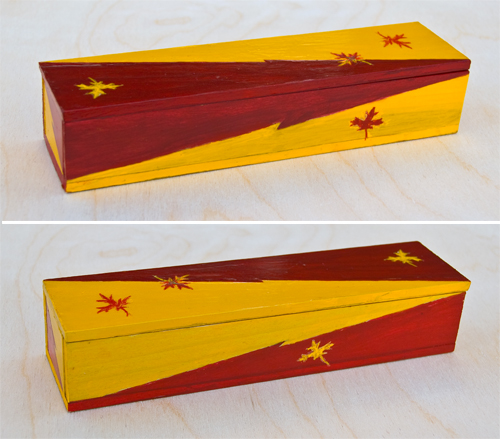
My friend Genji offered to handcraft a small wooden box for me. Given the choice of colors, I selected red and yellow, the autumn colors of maple leaves. The design that Genji thought would appeal to me, based on examples of my favorite art shared with him, is the zig-zag or lightning bolt pattern, the geometric design seen on Lacquer boxes of the Momoyama period (1568-1615).
To my comment: Looking at your box lengthwise, so far, I prefer looking at the yellow lightning bolt. It will be interesting to find out whether I prefer different sides when I am in different moods.
Genji replied: You’ve hit upon one of the really interesting facets of the lightening bolt design in that it presents different faces, sometimes opposing and sometimes complementing each other. The observer may sometimes prefer one, sometimes the other, sometimes both equally, for clear or subtle reasons. Japanese art often goes deep.
Indeed, this morning, I prefer looking at the lightning bolt in red. My new preference for the red zig-zag may, in part, reflect that I am in the process of selecting different hues of red pigments, iron oxides, for my current painting. Looking at the red lightning bolt now makes me feel better than looking at the yellow one – a change of emotion.
Googling ‘lightning bolt pattern’ brought up: In ancient mythologies from many cultures, the lighting bolt would be hurled by male sky gods to punish, water, or fertilize the earth or its creatures.
It makes sense that the lightning bolt pattern appealed to Japanese feudal barons or warlords who had reunified their countries after a period civil strife and were now subsidizing the arts, as seen in the gilded pieces below. 

Birgit:
I’ve heard of lightning in a bottle, but a boxed bolt is new to me.
Birgit,
I love the colors and the reversibility of the design. I suspect that I would change the orientation not so much according to mood as just for variety.
The Japanese gilded designs are interesting in the way the simply geometry of the lightning bolt is played off the complexity of the surrounding pictures. Especially intriguing is that on the box, the left side appears mostly to be part of a repeating pattern (though I’m not sure it’s regular), while the right side is a non-repeating landscape.
What do you put in the box?
Steve,
That is interesting, landscape versus design.
So far, the box has two contents, a yin-yang in red-yellow and a pebble from the beach with a yin-yang like pattern.
Very nice.
I love boxes. I used to collect antique boxes and still have a couple around the house, including one that stores a moccasin repair kit. The box is made of nickel with a raised Asian design, including Chinese characters. Very interesting juxtaposition.